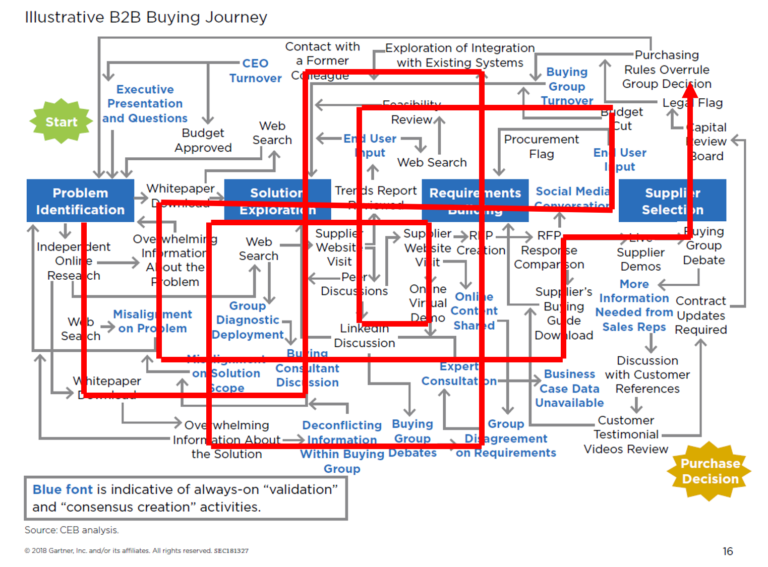
Our customers don’t know what they don’t know
Recently, I was in a discussion with a group of outstanding sales people. They were talking about how to align their selling process with the customer buying process.
One of the sales people asked, “How do we learn their buying process?”
Some readers may think, “Isn’t this obvious?” After all, classically, we know we have to do discovery, what are their needs and requirements, who’s involved, what is their decision-making process, what alternatives are the considering……
It’s all sales 101, so why do we struggle so much in understanding the customer buying process.
There is no buying process
Implicit in these questions is there is a defined, linear buying process. Just as we have always thought about a linear sales process (prospect, qualify, discover, propose, close); we tend to think customers have a similar process. Often, we go through defining a corresponding customer process (problem definition, need identification, evaluate alternative solutions, solution selection.)
While at a high level, this makes sense, after all, it’s a textbook problem solving process. But the reality is, this isn’t how things get done in organizations—as much as we might wish that it is.
We are reminded, 53% of complex B2B customer buying journeys—that is buying initiatives that are budgeted—end in no decision made.
Somehow, 53% of the well intended buying initiatives end in no decision made! Customers start them with the intent of addressing an issue and solving a problem. But the end up failing to make a decision and abandoning the initiative. (Note, there is a difference between no decision made and choosing to do nothing.)
 The reality is, our customers don’t have a buying process, they have a general idea of activities they might have to conduct–for example, assess alternative solutions. but they don’t know how to buy. They don’t know how to align the buying group, they may not know who should be involved in the buying group. They don’t know what questions they should be asking–of themselves and of the vendors. They don’t know what they don’t know.
The reality is, our customers don’t have a buying process, they have a general idea of activities they might have to conduct–for example, assess alternative solutions. but they don’t know how to buy. They don’t know how to align the buying group, they may not know who should be involved in the buying group. They don’t know what questions they should be asking–of themselves and of the vendors. They don’t know what they don’t know.
We tend to overestimate the customer’s ability to define and manage their buying process.
As an aside, this shouldn’t be surprising, as we look at failure rates of internal collaborations and projects, customers (and we) struggle with managing these successfully. So buying should be no different.
As you think, more deeply, particularly for complex B2B purchases, why should the customer know how to buy, why should they know their buying process? After all, how many times in their careers do customers make these buying decisions?
Even if it’s every few years, the world changes in the interim. Solutions change, markets change, problems/opportunities change, people involved in the buying team change. So past experience is probably not very helpful for a current buying initiative.
Recent similar purchases may be helpful in thinking about this, but there are real limitations. The buying group may be very different, the situations are very different, the problems are very different, they expected outcomes are different. So recent experience in similar areas may not be as informative as we might think.
While it’s important for sellers to focus on the customer buying process, how they are going to buy, and how we facilitate it, it doesn’t follow that the customer knows how to buy.
As a result the greatest value we can create is to teach them how they might buy:
- What are they trying to accomplish and why is it important to them? When do they have to have a solution in place? What are the consequences of not having something in place by that time?
- Who should be involved in this process and why should they be involved?
- What are the roles of each person in the buying team, how should they be working together?
- What questions should be be asking ourselves? What questions should be be asking people in the organization? What questions should we be asking vendors?
- Who has done this before and what can we learn from them?
- What are the critical activities we should be conducting in our process?
- What are the change management issues? What are the risks, how are those managed? (Risks are both organizational and personal.)
- How do they get buy-in from the rest of the organization?
- and on and on…..
It’s complex—that’s why it’s called complex B2B buying. Our customers have little experience in this, and, as much as they may want to, struggle with defining their process.
I think we tend to overestimate the customer’s ability to define and manage their buying process. As a result, the definition of the buying process may become a collaborative effort between the customer and us (and our competitors.)
This sales team was on the right track. They were focused on how the customer buys, aligning their selling activities to how the customer buys. But what they recognized is the customer can’t answer this question, so their greatest value was helping the customer discover the answers to that question.

By Dave Brock
Dave has spent his career developing high performance organizations. He worked in sales, marketing, and executive management capacities with IBM, Tektronix and Keithley Instruments. His consulting clients include companies in the semiconductor, aerospace, electronics, consumer products, computer, telecommunications, retailing, internet, software, professional and financial services industries.
Find out more about Dave Brock on LinkedIn







